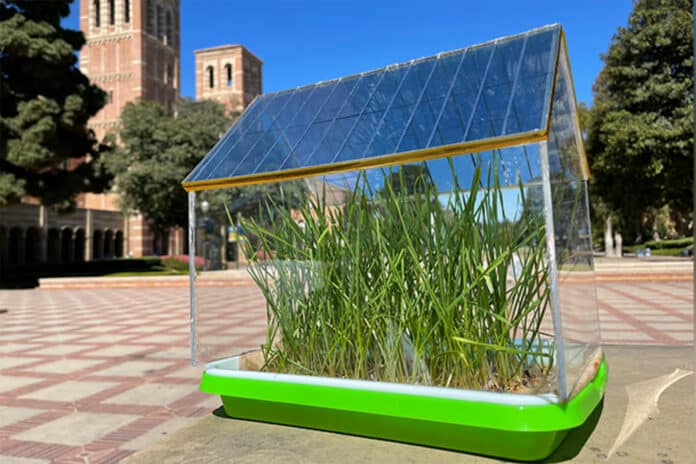As countries around the globe seek sustainable energy sources, renewable energy sources such as solar panels are in high demand. However, the deployment of large solar farms to feed the growing global population is difficult and can take up significant space.
Researchers at the Samueli School of Engineering at the University of California, Los Angeles (UCLA) have now explored a new, viable application of solar cells that do not require large plots of land. They have developed a miniature greenhouse prototype with its roof built of semi-transparent solar cells that resulted in better plant growth than a traditional greenhouse.
Semi-transparent organic photovoltaics are an emerging solar-energy-harvesting technology with promising applications, such as rooftop energy supplies for environmentally friendly greenhouses. However, the main drawback that has prevented their widespread use up to now is their lack of stability.
Organic solar cells tend to degrade more quickly than their inorganic counterparts because sunlight can cause organic materials to oxidize and thus lose electrons.
The team has developed a strategy for augmenting semi-transparent organic solar cells that rely upon carbon-based materials, as opposed to the inorganic substances in conventional devices. They added a new ingredient – a layer of a naturally occurring chemical called L-glutathione, which is sold as an antioxidant dietary supplement over the counter.
Researchers found that the additional layer prevented the other materials in the solar cell from oxidizing and breaking down. It extended the solar cells’ lifetime, improved their efficiency, and still allowed adequate sunlight to reach plants in a greenhouse prototype about the size of a small dollhouse.
In tests, organic solar cells with this protective layer maintained more than 80% efficiency after 1,000 hours of continuous use, while those without it dropped to under 20% in that time.
The researchers also tracked the growth of common crops, including wheat, mung beans, and broccoli, in two separate miniature greenhouse prototypes. One had a transparent glass roof with segments of inorganic solar cells, and the other had a roof made entirely from semi-transparent organic solar cells.
The semi-transparent organic photovoltaics demonstrate a power conversion efficiency of 13.5% and an average visible transmittance of 21.5%. Also, the team found that the crops in the greenhouse with the organic solar roof grew, surprisingly, more than the crops in a regular greenhouse. Researchers suggest this is because the L-glutathione layer blocks ultraviolet rays, which can inhibit plant growth, and infrared rays, which can cause greenhouses to overheat and plants inside to require more water.
“We didn’t expect the organic solar cells to outperform a conventional glass-roof greenhouse,” said Yepin Zhao, the lead author of the research and a UCLA postdoctoral scholar in Yang’s lab. “But we repeated the experiments multiple times with the same results, and after further research and analysis, we discovered that plants don’t need as much sunlight to grow as we’d originally thought. In fact, too much sun exposure can do more harm than good, especially in climates such as California’s, where sunlight is more abundant.”
The team has now established a startup at UCLA that aims to scale up the production of organic solar cells for industrial use. The researchers said they hope to make environmentally friendly greenhouses that incorporate organic solar cells commercially available in the future.
Journal reference:
- Yepin Zhao, Zongqi Li, Caner Deger, Minhuan Wang, Miroslav Peric, Yanfeng Yin, Dong Meng, Wenxin Yang, Xinyao Wang, Qiyu Xing, Bin Chang, Elizabeth G. Scott, Yifan Zhou, Elizabeth Zhang, Ran Zheng, Jiming Bian, Yantao Shi, Ilhan Yavuz, Kung-Hwa Wei, K. N. Houk, and Yang Yang. Achieving sustainability of greenhouses by integrating stable semi-transparent organic photovoltaics. Nature Sustainability, 2023; DOI: 10.1038/s41893-023-01071-2
